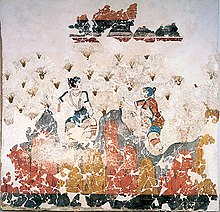
Human cultivation and use of saffron spans more than 3,500 years[1][2] and extends across cultures, continents, and civilizations. Saffron, a spice derived from the dried stigmas of the saffron crocus (Crocus sativus), has through history remained among the world's most costly substances. With its bitter taste, hay-like fragrance, and slight metallic notes, the apocarotenoid-rich saffron has been used as a seasoning, fragrance, dye, and medicine.
The wild precursor of domesticated saffron crocus was likely Crocus cartwrightianus, a plant native to mainland Greece, Euboea, Crete, Skyros and some islands of the Cyclades. This species has been used as a wild source of saffron.[3] A study reported in 2019 that the authors considered that a cross between two cytotypes of Crocus cartwrightianus was responsible for the emergence of Crocus sativus. This was probably a unique or very rare event as there is no genetic diversity in commercial saffron today.[4] Another study in 2019 showed that a population of Crocus cartwrightianus near Athens in Attica was the closest match to the theoretical ancestors of Crocus sativus.[5]
C. thomasii and C. pallasii have previously been suggested as possible ancestors.[6][7] There has been much theorising about its origin,[8] with suggestions that saffron originated in Iran (Persia),[9] Greece,[10] Mesopotamia[11] and even Kashmir.[12]
Several wild species of Crocus are known to have been harvested for use as saffron. Crocus ancyrensis was used to make saffron in Sivas in Central Turkey, the corms were also eaten. Crocus cartwrightianus was harvested on Andros in the islands of the Cyclades, for medicinal purposes and the stigmas for making a pigment called Zafran. Crocus longiflorus stigmas were used for saffron in Sicily. Crocus thomasii stigmas were used to flavour dishes around Taranto, South Italy. In Syria the stigmas of an unknown wild species were collected by women and children, sun-dried and pressed into small tablets which were sold in the Bazaars.[13]
The saffron crocus is now a triploid that is "self-incompatible" and male sterile; it undergoes aberrant meiosis and is hence incapable of independent sexual reproduction—all propagation is by vegetative multiplication via manual "divide-and-set" of a starter clone or by interspecific hybridisation.[14][7] If C. sativus is a mutant form of C. cartwrightianus, then it may have emerged via plant breeding, which would have selected for elongated stigmas, in late Bronze Age Crete.[15]
Humans may have bred C. cartwrightianus specimens by screening for specimens with abnormally long stigmas. The resulting saffron crocus was documented in a 7th-century BC Assyrian botanical reference compiled under Ashurbanipal,[16] and it has since been traded and used over the course of four millennia and has been used as treatment for some ninety disorders.[17] The C. sativus clone was slowly propagated throughout much of Eurasia, later reaching parts of North Africa, North America, and Oceania.
- ^ Deo 2003, p. 1.
- ^ Hogan 2007.
- ^ Jacobsen, Niels; Ørgaard, Marian (2004). "Crocus cartwrightianus on the Attica Peninsula" (PDF). ISHS Acta Horticulturae. 650 (6): 65–69. doi:10.17660/ActaHortic.2004.650.6. Retrieved 6 April 2024.
- ^ Schmidt, Thomas; Heitkam, Tony; Liedtke, Susan; Schubert, Veit; Menzel, Gerhard (June 2019). "Adding color to a century-old enigma: multi-color chromosome identification unravels the autotriploid nature of saffron ( Crocus sativus ) as a hybrid of wild Crocus cartwrightianus cytotypes". New Phytologist. 222 (4): 1965–1980. doi:10.1111/nph.15715. PMID 30690735. Retrieved 6 April 2024.
- ^ Nemati, Zahra; Harpke, Dörte; Gemicioglu, Almila; Kerndorff, Helmut; Blattner, Frank R. (2019). "Saffron (Crocus sativus) is an autotriploid that evolved in Attica (Greece) from wild Crocus cartwrightianus". Molecular Phylogenetics and Evolution. 136: 14–20. doi:10.1016/j.ympev.2019.03.022. PMID 30946897. Retrieved 6 April 2024.
- ^ Negbi 1999, p. 28.
- ^ a b Grilli Caiola 2003, p. 1.
- ^ "Saffron, an alternative crop for sustainable agricultural systems.Areview". HAL: 95. 2008. Archived from the original on 20 September 2022. Retrieved 5 February 2019.
- ^ Lichtfouse, Eric (13 July 2017). Sustainable Agriculture Reviews. Springer. p. 170. ISBN 9783319586793. Archived from the original on 19 January 2023. Retrieved 12 July 2022.
- ^ "Saffron, an alternative crop for sustainable agricultural systems.Areview". HAL: 95. 2008. Archived from the original on 20 September 2022. Retrieved 5 February 2019.
- ^ Lichtfouse, Eric (13 July 2017). Sustainable Agriculture Reviews. Springer. p. 171. ISBN 9783319586793. Archived from the original on 19 January 2023. Retrieved 12 July 2022.
- ^ Saffron : science, technology and health. A. Koocheki, Mohammad Khajeh-Hosseini. Duxford, United Kingdom. 2020. ISBN 978-0-12-818740-1. OCLC 1140113593. Archived from the original on 19 January 2023. Retrieved 28 March 2022.
{{cite book}}: CS1 maint: location missing publisher (link) CS1 maint: others (link) - ^ Maw, George (1886). A Monograph of the Genus Crocus. Soho Square, London: Dulau and Co. pp. 87, 164, 207, 250. Retrieved 6 April 2024.
- ^ Negbi 1999, p. 30–31.
- ^ Negbi 1999, p. 1.
- ^ Russo, Dreher & Mathre 2003, p. 6.
- ^ Honan 2004.